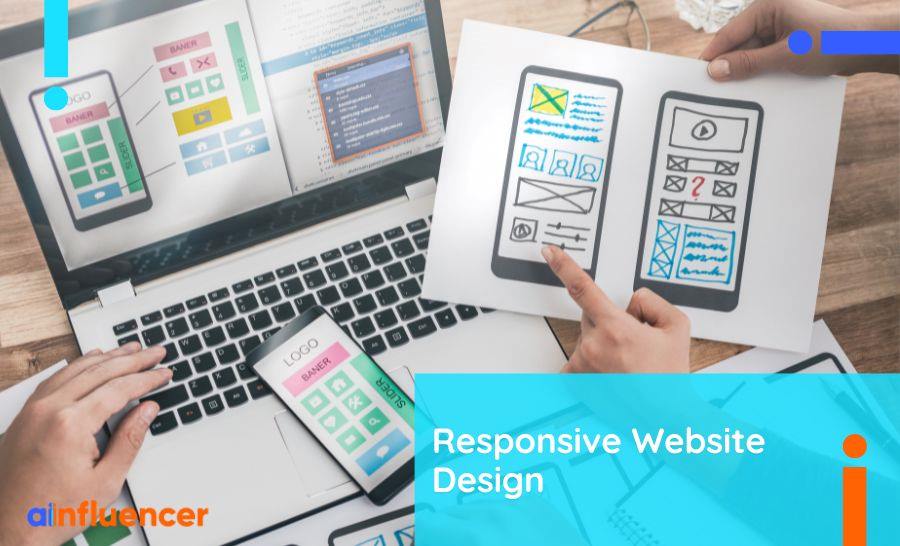Web development is a much-needed skill in modern industry. As most businesses shift online, the demand for professional and competent web developers has skyrocketed. In such an economy, a responsive website holds the central position for every business.
Aspiring web developers must understand the current trends in web development and what features they must focus on intensively. From the planning stage to the final testing of the website, including online shopping websites, adhering to technical guidelines is essential to develop a robust, functional, and secure website.
Here are some guidelines on what to focus on in every stage of web development to end up with a responsive website.
Planning and Architecture
The web development process starts much before you develop actual code: the planning stage is just as technically important as the coding stage. Remember to make note of the following features when planning your website:
1. Defining Website Goals
Website designers base the technical structure of their website on the website goals, so you must determine them at the start.
The purpose drives the design, functionality, and content: while an e-commerce marketing website will focus on product listings and smooth checkout processes, a blog site will emphasize content management and engagement features.
Aligning website goals with broader business objectives ensures the site contributes effectively to the company’s overall strategy. The website will focus on lead generation and conversion optimization if a business aims to increase market share.
2. Identifying Target Audience
Understanding the demographic profile of your target audience is vital in tailoring the design and content. Focus on key demographic features like age, gender, location, occupation, income level, and education to design the website accordingly.
For example, a website targeting young adults might prioritize mobile optimization and social media integration more. One strategy that can help in identifying the target audience is creating detailed user personas.
When developing a user persona, include demographic details, behavior patterns, motivations, and pain points.
3. Determining Key Functionalities
The key functionalities of your website can be divided into core features and future enhancements. The core features vary depending on the website: an e-commerce website can include a product catalog, shopping cart, payment gateway, and customer reviews.
Although future enhancements can be added later when the business grows, they must be considered during the planning process. Ensure you add the potential to scale up the website and adapt it to future business needs.
Some future functionalities can include advanced analytics or user forums.
4. Choosing the Right Technology Stack
Selecting the right front-end technologies involves choosing tools to create an engaging and responsive website interface. Technologies like HTML, CSS, and Javascript are foundational, and frameworks like Angular and Vue enhance development efficiency and performance.
So, which front-end technologies should you choose for your project? It depends upon your website’s complexity, your expertise, and your performance requirements.
Back-end technologies also depend upon your project. Some popular choices include Node.js for its non-blocking, event-driven architecture and Django for its high-level Python framework.
Since the back-end is responsible for server-side logic, database interactions, and API integration, your choice of technology will ensure efficient data handling, security, and scalability.
5. Planning Site Architecture
Developing a site map is a crucial step in visualizing the website structure and navigation. A site map outlines the primary sections and pages, illustrating how users will interact with the website. It helps organize content logically, ensuring that users can easily find the information they need.
The better you plan your site architecture, the better your SEO will get, as the website will be more accessible and user-friendly.
Consider using wireframes, which are low-fidelity sketches that outline your webpages’ basic structure, prototypes, and interactive models that stimulate the user experience, to plan the layout and user interface. Also, don’t forget about an SEO audit to help your website rank better.
You must ensure that the architecture allows for future growth and easy maintenance, so keep scalability in mind when planning the architecture. Design the website to handle increasing data and traffic without compromising performance. Some strategies you can look into include modular design, efficient coding practices, and cloud computing.
6. Plan for Influencer Marketing
Social media and influencer marketing have become a cornerstone of businesses. Every major e-commerce website includes links for influencers and social media pages.
When designing your website, it is essential that you integrate it with social media widgets that lead to your TikTok or Instagram pages. Similarly, you must plan an element on your website to highlight and emphasize influencer endorsements and collaborations.
Best Coding Practices
Once you have planned your website’s outlook, desired features, and architecture, it is time to get coding. When writing your code, be wary of the following:
1. Writing Semantic HTML
HTML is more than just your web development language: it is a tool for your SEO, too. Semantic HTML elements like <header>, <article>, and <footer> provide meaningful context to the content and help search engines understand the structure and hierarchy of the webpage.
For example, an <article> tag will tell the search engine that the webpage is a standalone piece.
Semantic HTML elements also improve accessibility by providing elements that assistive technologies like screen readers can easily read. These technologies use the semantic structure to navigate and present content to users with disabilities.
For example, a <nav> tag will tell screen readers that this section is a navigation aid.
2. Using CSS Preprocessors
CSS preprocessors like SASS and LESS enhance coding reusability and efficiency. They introduce features like variables, nesting, and mixings, which help streamline the styling process.
Preprocessors can organize CSS into smaller, modular files that make managing and updating styles easy. As a developer, you can create multiple partials focusing on different sections of the website instead of using a single style sheet.
This allows the development process to be simplified and facilitates targeted modifications. Another advantage of CSS preprocessors is that they can handle vendor prefixes, ensuring better browser compatibility.
Preprocessors can generate the necessary prefixes for different browsers, allowing developers to write cleaner and more concise CSS.
3. Adopting JavaScript Libraries
Selecting the right JavaScript framework depends upon the project requirements and developer expertise. As discussed earlier, Angular and Vue are popular choices: Angular is more suitable for large-scale applications, while Vue suits medium-scale interfaces.
JavaScript frameworks and libraries improve performance and efficiency by offering reusable components. Through these tools, you can streamline the development by providing pre-built structures and functionalities, reducing the need for redundant code. For example, Angular’s dependency injection can simplify data management.
4. Following Coding Standards and Conventions
Maintaining a consistent code style across the project enhances readability and collaboration. Ensure your team adheres to a unified style and follows the same conventions so the codebase is uniform and easier to understand. You can consider using tools like Prettier to automate code formatting.
Using the BEM naming convention can help maintain a consistent and understandable CSS structure. The BEM (block, element, modifier) methodology provides a systemic naming pattern in which blocks are standalone components, elements are part of blocks, and modifiers indicate variations.
You can use linting tools like ESLint to make your JavaScript coding consistent. It will enforce coding standards, catch errors early, and improve code quality. Through such tools, you can also promote consistency across the codebase.
Responsive Website and Mobile Optimization
As technology progresses, the sizes of devices have gotten smaller. Most people access the web from small phones that fit in their pockets instead of PCs, and optimizing the web for small screens is a major challenge for web developers.
Here are some tips for building a responsive website and optimizing it for mobile phones:
1. Using Media Queries
Media queries are powerful features in CSS that allow you to adapt your UI per characteristics of the user’s device, such as screen width, height, orientation, and resolution, allowing for building a responsive website.
This ensures that the website provides an optimal viewing experience, regardless of your device. For example, a media query can change the layout from the multi-column format on desktops to a single-column format for mobile devices.
Common media queries include breakpoints for different screen widths, such as 480px for phones and 1024px for desktops. Such responsive website design enhances website readability and accessibility and improves SEO, as search engines favor mobile-friendly and responsive websites.
Responsive website design is also easier to maintain than developing separate mobile and desktop versions.
2. Mobile-First Approach
The mobile-first design approach involves designing for the smaller screen sizes first and then scaling up for larger devices, as opposed to designing for larger devices and then optimizing for phones.
Through this strategy, you prioritize essential content and functionality, ensuring the website performs well on phones, which has become the primary way many users access the web.
As the developers focused on mobile constraints at the start, a responsive website has a clean and efficient design. With the scalable design approach, you can then accommodate larger screens, which ensures that the core functionality and content remain intact and accessible on all devices.
Techniques such as fluid grids and flexible images allow developers to adjust layouts dynamically.
3. Cross-Device Testing
Cross-device testing is essential to ensure that a responsive website functions correctly and provides a consistent user experience across various devices and browsers.
Different devices and browsers render websites differently, leading to issues with the layout and performance. You can use tools like BrowserStack, Sauce Labs, and Chrome DevTools to facilitate cross-device testing.
BrowserStack and Sauce Labs provide cloud-based platforms that allow developers to test their websites on multiple platforms without needing physical devices, while Chrome DevTools emulates different screen sizes and network conditions, allowing developers to diagnose and fix issues quickly.
If you detect any compatibility issues, feature detection libraries like Modernizr can help implement fallbacks for unsupported features. Maintaining a robust and consistent codebase, adhering to web standards, and leveraging polyfills for older browsers can mitigate compatibility problems.
Performance Optimization
Slow loading speeds, technical issues, and poor performance are major challenges for web developers. Here is how you can optimize your website’s performance:
1. Minimizing HTTP Requests
Minimizing the number of HTTP requests is crucial for enhancing website performance, as each request adds latency, slowing down page load times. You can reduce HTTP requests by combining multiple CSS and JavaScript files into single files, reducing the number of assets that need fetching.
You can also use CSS sprites, combining multiple images into a single sprite sheet and displaying only the required portion. Additionally, you can inline smaller images directly into HTML or CSS using data URLs and reduce HTTP requests.
As large, unoptimized images slow down page load times, you should consider compressing them to reduce file size without sacrificing quality to reduce load times.
2. Tools to Identify and Fix Performance Issues
There are different tools that help developers identify and fix performance issues, such as Google PageSpeed Insights. It provides a detailed report on various performance metrics, including page load speed, time to interact, and potential issues for any URL.
It also offers specific recommendations, such as optimizing images, leveraging browser caching, and eliminating render-blocking resources.
These insights help developers prioritize fixes that can have the most significant impact on performance. It also scores both desktop and mobile performance for different metrics, allowing you to assess your responsive website.
Other performance tools include GTmetrix, which provides in-depth reports on page load speed along with recommendations, and Lighthouse, which audits performance, accessibility, and SEO.
3. Lazy and Asynchronous Loading
Lazy loading and asynchronous loading are two techniques used to optimize performance. Lazy loading defers the loading of offscreen images until the user scrolls to them, improving initial page load times and reducing bandwidth usage.
By only loading images that are needed, lazy loading minimizes the amount of data transferred during the initial load, speeding up page rendering.
The lazy loading technique can drastically improve load times when pages have multiple images, such as in long articles or galleries.
Likewise, asynchronous loading is used for JavaScript files and prevents them from blocking the page’s rendering, significantly enhancing load times. The scripts are downloaded in the background and executed when they are ready without interrupting the HTML parsing.
This approach is useful for scripts that are not critical for the page’s initial rendering, such as social media widgets.
4. Leveraging Browser Caching and CDNs
Browser caching stores static resources such as images, CSS files, and scripts on the user’s device after the first visit. This allows subsequent page loads to be faster as the browser retrieves these resources from the local cache instead of the main server.
Similarly, Content Delivery Networks (CDNs) improve performance by distributing content across a network of servers located around the globe.
When a user requests a resource, it is delivered from the server closest to their geographic location, reducing latency and speeding up load times. CDNs also help balance traffic loads, providing redundancy and increasing reliability. Popular CDNs include Cloudflare and Akamai.
Endnote
Website development is a major skill in demand as the world transitions to the digital landscape. Every business needs a digital presence, so website development is an in-demand skill. To design a responsive website, you must focus on its user-friendliness and performance optimization.
The process of designing a website starts from its planning stage, and you must follow the best practices throughout coding to design a responsive website.
FAQs
A responsive website is one that adapts its layout and design to provide an optimal viewing experience across various devices and screen sizes. This includes desktop computers, laptops, tablets, and smartphones.
In essence, a responsive website ensures that the content, images, and functionality remain accessible and user-friendly regardless of the device being used to access it.
By employing techniques such as flexible grids, media queries, and fluid images, web developers ensure that the website adjusts dynamically to different viewport sizes, orientations, and resolutions.
To make sure your website is responsive, use coding tricks like media queries to change how the site looks based on the device. Start by designing for mobile devices first, then scale up for larger screens. Test your website on different devices and browsers to make sure it works well everywhere.
Also, optimize images and follow performance tips to make sure your site loads quickly on mobile devices.




![Read more about the article What Is Walmart Creator Program: [The Comprehensive Break-down + Best Alternative in 2024]](https://blog.ainfluencer.com/wp-content/uploads/2023/12/Copy-of-Ainfluencer_Content_Images-12-1-300x182.jpg)




